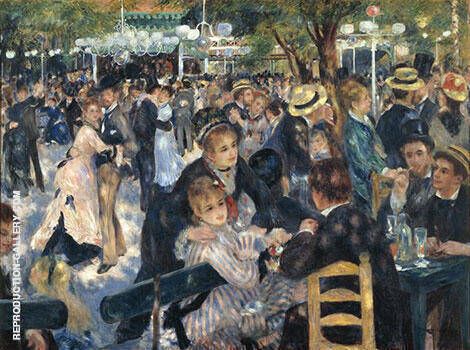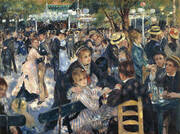Bal du Le Moulin de la Galette 1876 By Pierre Auguste Renoir
Bal Au Moulin de la Galette by Pierre-Auguste Renoir
Renoir Bal du Moulin de la Galette, or Dance at Le Moulin de la Galette, is one of Pierre Auguste Renoir’s famous Impressionist paintings.
Learn More about Renoir's famous Impressionist Painting.
Painted by Pierre Auguste Renoir in 1876, this oil on canvas painting depicts a Sunday afternoon spent by Moulin de la Galette patrons. This 17th century Windmill was a popular bar and restaurant near the top of the Montmartre district in Paris. Towards the end of the 19th century, such establishments were enormously popular—various classes of French society mixed with working classes, rubbing shoulders with creatives and elites.
Everyone is dressed in their finest clothes, dancing, drinking, and dining late into the evening. One of the most popular dishes was, unsurprisingly, galettes. This form of round pastry or pancake pie usually has a savory or fruit filling and is common all over France. Frequented by much of the Parisian avant-garde, other artists such as Vincent van Gogh, Henri de Toulouse Lautrec, and Camille Pissarro also painted the iconic building. For instance, it appears in Vincent Van Gogh’s painting Moulin de la Galette 1886 and Pablo Picasso’s Le Moulin de La Galette 1900.
What is the Meaning of Bal au Moulin de la Galette?
Renoir’s famous painting is similar to other early paintings by the artist. In terms of meaning, it simply reflects Pierre-Auguste Renoir’s interest in capturing an accurate snapshot of everyday life. The colors are light and bright, the people smiling and crowded into the space. The rich form completes the composition of the painting. Fluid brushstrokes and flickering sun-filled effects reflect other Renoir paintings. Perhaps his best-known light-filled creation, The Luncheon of the Boating Party, was painted in 1881.
Renoir also produced a replica painting in a smaller version. Both paintings depict dancing at the Moulin de la Galette and are almost identical in color and composition. The smaller oil painting is more fluid and accessible in form, suggesting a quicker artistic study. It is still unknown which painting is the original. We do not even know which version first appeared at the Third Impressionist Exhibition of 1877. However, the painting received favorable reviews from critics and the public alike.
Why did Renoir Paint the Dancers at the Moulin de la Galette?
In the Spring of 1876, Renoir discussed creating an energetic dancing painting at Le Moulin de la Galette. Pierre Auguste Renoir wanted to capture the reality and beauty of everyday life. Pierre Renoir’s friend, Georges Rivière, described the execution of the painting in minute detail. In a memoir titled Renoir et ses Amis, Rivière describes how Renoir painted his masterpiece on the spot. He mentions the wind threatening to blow Renoir’s canvas away multiple times.
Renoir rented a studio near the Moulin de la Galette to perfect the painting. He located an abandoned cottage with a beautiful park-like garden in the nearby Rue Cortot. Renoir’s famous paintings were also painted here, including The Swing. Painting “en Plein air” is an essential characteristic of Impressionist artists. The art movement prioritizes the effects of light, the passage of time, and ordinary everyday life subject matter. Renoir was a key participant and early pioneer of Impressionist paintings.
Collaborating with famous impressionist artists Claude Monet and Frederic Bazille, Renoir championed the Impressionist artists and their painting style. Renoir’s short, broken brushstrokes are perfectly exemplified in Bal du Moulin de la Galette. The lack of traditional blending masterfully achieves a sense of flickering light and the heady vibration of Parisian life so prized by impressionist artists.
Who are the people in Renoir’s Famous Impressionist painting?
Renoir’s famous painting reflects the contemporary French society of the day. Despite this, and likely to save on models’ fees, many of the individuals in the painting were close acquaintances. In Georges Rivière’s memoirs, he identified many of the sitters. Renoir tried persuading his favorite model Jeanne Samary to pose for the painting. Uninterested, she remained uninvolved. Consequently, Jeanne’s sister Estelle appears as the young girl in a blue and pink striped dress. Jean Samary and her sister visited le Moulin de la Galette every weekend. Chaperoned by their mother, they enjoyed the festivities and dancing throughout the warm French summer.
Other identifiable figures in the group next to Estelle include Pierre-Franc Lamy, Norbert Goeneutte, and Rivière himself. Goeneutte also features in Renoir’s The Swing painting. Amongst the swirl of dancers behind are other friends of Renoir, Eugène Pierre Lestringuez, and Henri Gervex. Moving further back into the depths of dancers, Don Pedro Vidal de Solares y Cárdenas, a leading Cuban painter, wears striped trousers. He dances with a model named Marguerite Legrand.
Known as Margot, Legrand attempted to entertain surly Solares by dancing energetic polkas and singing risqué local songs—another Pierre Auguste-Renoir model, who sadly died just two years after this painting. Margot suffered from typhoid, and Renoir cared for her until her death, paying for her funeral and hospital treatment.
What is the value of Bal du Moulin de la Galette?
Bal du Moulin de la Galette is highly prized even amongst Pierre-Auguste Renoir famous paintings. While the larger painting remained in France, the smaller version resided with John Hay Whitney, US ambassador to the United Kingdom, for many years.
In 1990, Whitney’s surviving family sold the painting for $78 million at Sotheby’s New York auction house. Purchased by Ryoei Saito, chairperson of the Daishowa Paper Manufacturing Company in Japan, it was one of the most expensive oil paintings ever sold. At the time, Van Gogh’s Portrait of Dr. Gachet, was the only more expensive Portrait of Dr. Gachet, both controversially purchased by Saito. Indeed, Saito sparked international outrage when he announced he intended to cremate the two paintings after his death. Despite this, the paintings were saved when Saito later sold them through Sotheby’s to an unknown Swiss collector.
Where is the Bal du Moulin de la Galette now?
Today, the larger Bal du Moulin de la Galette resides in Paris. From 1897 to 1894, Gustave Caillebotte, the French artist and patron of the Impressionist art movement, owned Pierre Auguste Renoir's paintings. On his death, ownership was transferred to the French state, in part payment for death duties. After that, the painting hung in the Musée du Luxembourg in Paris until 1929. It moved to the Musée du Louvre in 1929, where the painting remained until 1986. Today the painting resides in the Musée d'Orsay in Paris.
Bal du Moulin de la Galette is one of the most famous Impressionist oil on canvas paintings. Bal de Moulin de la Galette is one of the most loved Pierre Auguste Renoir paintings. It provides a fascinating insight into Parisian life and culture at the end of the 19th century.
We have been creating fine art reproductions since 1996; we are the original reproduction oil painting company. We currently have over 30,000 famous paintings in our online art catalog, all covered by our 100% Money Back Guarantee.
You can buy your museum-quality oil painting reproduction online here.
We offer a 100% money back guarantee or replacement service. If for any reason you are dissatisfied with your painting please contact us within 7 days of receipt, advising the reason you are unhappy and we will provide you with all the information you need for its return or replacement.
We ship free to anywhere in the world via FedEx or DHL expedited service with online tracking.
Your painting will be shipped rolled in strong plastic tubing, ready for stretching and/or framing locally. This is the conventional method of transporting hand-painted oil on canvas. Learn more about how your painting is shipped.
We are able to offer a framing service intercontinental U.S. Please contact us if you would like a quotation. Alternatively, should you prefer, we can recommend a framer in your area.
Notes About Your Painting
Please note that replica oil paintings are finished with an additional 10cm (4") of extra canvas on all sides, allowing ample surplus canvas for stretching and framing.
Recently Viewed:
Cannot Find What You Are Looking For?
Reproduction Gallery Information
Customer Service
(Send Us A Message)
Tel: (503) 937 2010
Fax: (503) 937 2011







